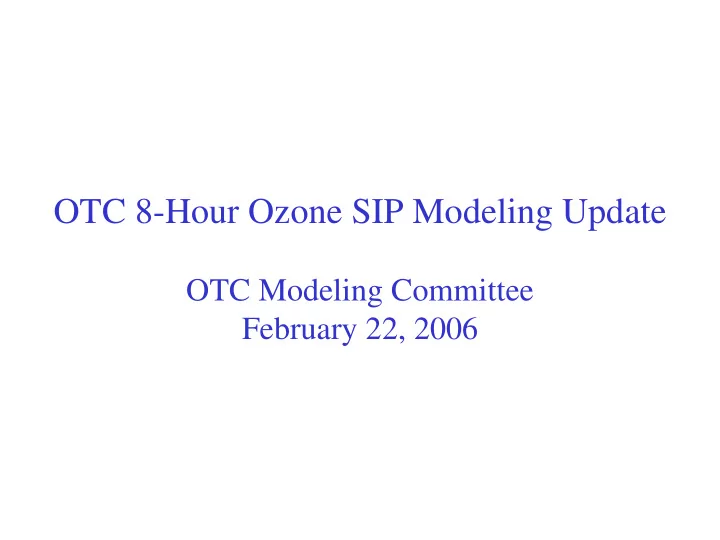

OTC 8-Hour Ozone SIP Modeling Update OTC Modeling Committee February 22, 2006
Presentation Topics 1. OTC Ozone SIP Modeling Platform 2. 2009 Preliminary Base Case CMAQ Model Run 3. CALGRID Screening Results to Date 4. Next Steps
1. OTC Ozone SIP Modeling Platform
Background • NYDEC set up the Ozone SIP modeling platform design and is performing CMAQ 4.4 modeling runs. • UMD with support from MDE developed the meteorological fields for 2002 using MM5. • MARAMA, on behalf of OTC and MANEVU, is working with contractor to prepare base case and future case emission files based on state emission inventories.
12 km Modeling Domain 36 km
2. Preliminary 2009 Base Case CMAQ Model Run
2002 Design Values in OTR The 2002 design values for OTC monitors is the average of the 8-hr ozone design values for the 2000-2002, 2001-2003, and the 2002-2004 three year periods
2009 Strategies: Base Case Control Programs On the Books/On the Way including… • NOx SIP Call, CAIR, State multi-P rules • Federal onroad and offroad fuels, vehicle standards, LEV programs (if applicable) • Federal MACT rules • OTC existing model rules for Consumer Products, AIM, DG, etc. • Any state-specific rules in effect by 2009
Relative Reduction Factors (RRF ) •For each high ozone day, the highest of 8-hour averages from the nine grid cells containing and surrounding each ozone monitor was selected. •The average of these maximum daily values for both the 2002 base case and the 2009 control case was then determined. •The RRF for each monitor was calculated by dividing the 2009 base case max daily average by the 2009 control case max daily average. RRF = 2009 av. daily max/2002 av. daily max
Control Case Design Value (DV) The 2009 control case ozone design value for each ozone monitoring station was determined by multiplying the 2002 base case ozone design value by the RRF calculated for each ozone monitor. 2009 DV = 2002 DV x RRF
Preliminary 2009 Design Values in OTR
OTR Domain – Preliminary Results 2002 Design Values 2009 Design Values
OTR Corridor – Preliminary Results 2002 Design Values 2009 Design Values
Findings for Preliminary 2009 Base Case Run • Design Values > 90 ppb at monitors in Connecticut, New York (Long Island), and New Jersey. • Design Values > 85 ppb are confined to monitors in the OTR corridor with the exception of two monitors around Buffalo. • Substantial portions of states in the OTR corridor have Design Values between 82 to 87 ppb. EPA requires a strong weight of evidence (WOE) analysis to support that 2009 control case design values could be below 85 ppb by 2009.
Some Important Caveats • OTR domain emission inventories have changed. CMAQ runs will be redone using version 3 of the OTC/MANEVU emission inventory and updated emission inventories for other RPO states. • Canada 2002 emissions were used for both 2002 and 2009 CMAQ runs (probably conservative). • CMAQ 4.4 was used. OTC Modeling Committee will use current state of the science model for the final attainment run (CMAQ 4.5?) Ozone predictions may change.
What This Tells Us • OTW/OTB controls are helping, especially reductions from the NOx SIP call. • Densely populated portions of the OTR are still non-attainment with the ozone NAAQS. • More emission reductions are needed… everything is still on the table.
3. CALGRID Screening Results to Date
CALGRID 2009 Design Values Based on 1995 Episode 2009 Base Run 1.0 Future Design Values for 8-Hour Ozone EPISODES June 12-23, 1995 July 5-15, 1995 Current Design Value (DVC) Average of 2000-2002, 2001-2003, 2002-2004 RRF Threshold1 = 85 PPB RRF Threshold2 = 70 PPB Emissions Base = 2002 Proxy 0 to 72 < 72 72 to 77 77 to 82 82 to 87 87 to 92 92 to 97 97 to 120 > 97 CALGRID Modeling Domain NHDES 2/21/06
CMAQ Preliminary 2009 Design Values in OTR
Benefits of 2009 vs. 2002 Includes CAIR and OTW/OTB 110 Ozone Concentrations 100 (PPB) 90 40 30 80 25 20 70 15 60 10 5 50 3 1 40 -1 30 -5 -10 20 -20 -30 10 Full Domain Controls NHDES 1/18/06 0 0 10 20 30 40 50 60 70 80 90 100 110 120 130 140
2009 - Benefits of Additional Local/Regional Controls Beyond CAIR and OTW/OTB 110 Ozone Concentrations 100 (PPB) 90 40 30 80 25 20 70 15 60 10 5 50 3 1 40 -1 30 -5 -10 20 -20 -30 10 LADCO/OTR Controls NHDES 1/23/06 0 0 10 20 30 40 50 60 70 80 90 100 110 120 130 140
2009 - Benefits of the All Identified Additional Regional Controls - Without Additional EGU Controls 110 Ozone Concentrations 100 (PPB) 90 40 30 80 25 20 70 15 60 10 5 50 3 1 40 -1 30 -5 -10 20 -20 -30 10 Full Domain Controls NHDES 1/26/06 0 0 10 20 30 40 50 60 70 80 90 100 110 120 130 140
4. Next Steps
CMAQ Work in Progress • MARAMA will complete the 2002 base case emission inventory (version 3) and prepare a 2009 OTB/OTW plus CAIR emission inventory (version 3). • NYSDEC will redo the 2002 base case run using the version 3 emission inventory and corresponding RPO emission inventories (by end of May?) • NYSDEC will redo the 2009 base case run using version 3 emission inventory and corresponding RPO emission inventories. If 2002 model performance with the version 3 emission inventory is OK, 2009 control case design values will be prepared (by end of June?)
CALGRID Work in Progress • States are working with NESCAUM, MARAMA and the OTC to identify additional state and regional level control strategies that may be necessary for demonstrating attainment of the 8-hour ozone NAAQS. • NH DES will be performing additional CALGRID screening runs for alternative control scenarios for the June OTC meeting.
Recommend
More recommend